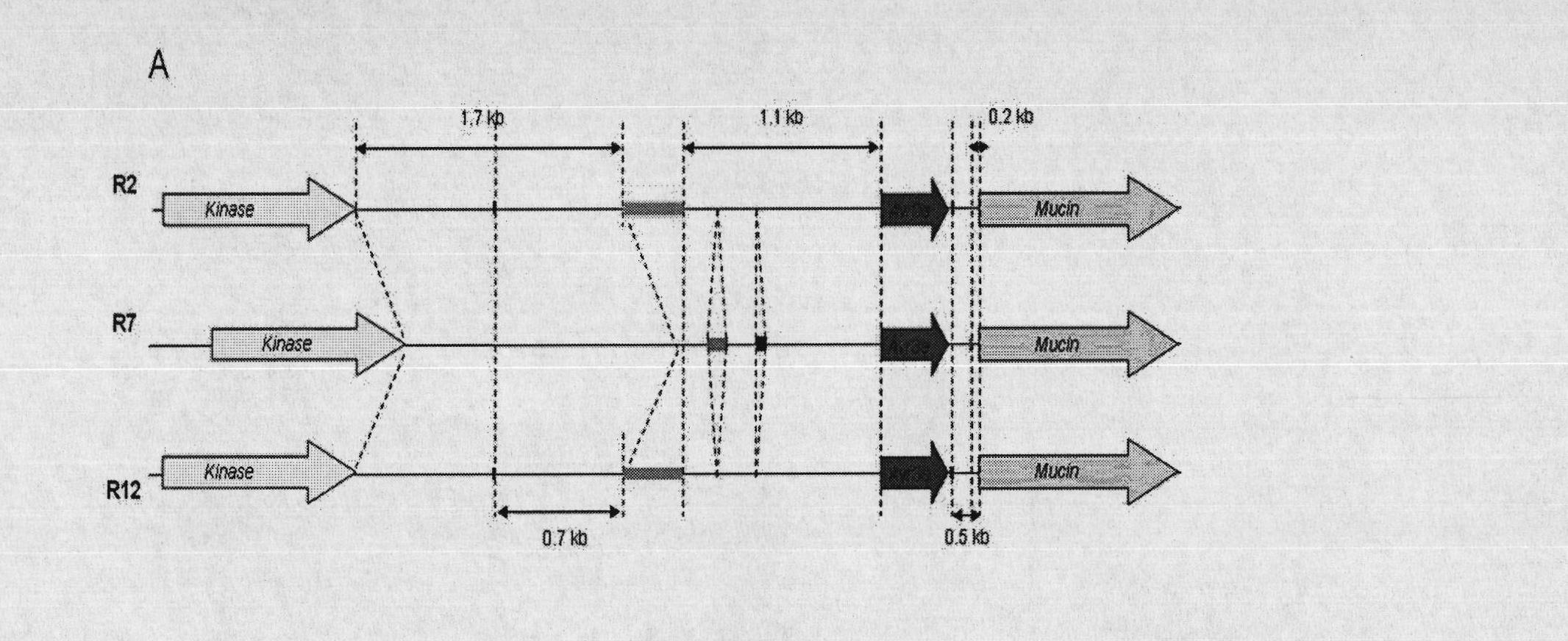Primer for detecting the soybean phytophthora and kit and method thereof
A technology of Phytophthora sojae and a kit, which is applied in biochemical equipment and methods, microbiological determination/inspection, DNA/RNA fragments, etc., and can solve the problems of reducing PCR reaction sensitivity, false positive of P.melonis, ITS sequence of Phytophthora species Differences and other issues
- Summary
- Abstract
- Description
- Claims
- Application Information
AI Technical Summary
Problems solved by technology
Method used
Image
Examples
Embodiment 1
[0031] Embodiment 1: Design, synthesize primer and establish the PCR reaction system of soybean Phytophthora detection kit
[0032] 1. Primer design and synthesis
[0033] According to the Phytophthora sojae transposon sequence (see figure 1 ) design a pair of specific primers TrapF1 / TrapR1 (see the nucleotide sequence table SEQ ID NO.1 and SEQ ID NO.2) for the molecular detection of Phytophthora sojae, in order to improve the sensitivity of detection, the present invention is based on the sequence design Another pair of primers TrapF2 / TrapR2 (for details, see SEQ ID NO.3 and SEQ ID NO.4 in the nucleotide sequence table) was used as the second round of amplification primers for nested PCR. All primers were synthesized by Shanghai Shenggong Company.
[0034] 2. Establish a conventional PCR reaction system
[0035] The total volume of the PCR reaction mixture is 25 μl, including: corresponding concentration of template DNA, 0.5 μM TrapF1 / TrapR1 primers, 50 μM each of the four...
Embodiment 2
[0038] Embodiment 2: Preparation of DNA template
[0039] Extract DNA from various samples as templates for PCR reactions. The specific process is as follows:
[0040] 1. Extraction of mycelium powder DNA
[0041] Refer to the method of Sambrook et al. (1989) and slightly improve it. Take a small amount of mycelium powder, add 900 μl 2% CTAB extract and 90 μl 10% SDS, vortex and mix well, put in a water bath at 55°C for 1 hour, and invert several times every 10 minutes. Centrifuge at 12000rpm for 10min, take the supernatant and add an equal volume of phenol / chloroform / isoamyl alcohol (25:24:1), mix by inverting, centrifuge at 12000rpm for 10min; transfer the supernatant to a new tube, add an equal volume of chloroform, and mix gently by inverting Evenly, centrifuge at 12000rpm for 5min. Transfer the supernatant to a new tube, add 2 times the volume of absolute ethanol and 1 / 10 volume of 3M NaAc (pH 5.2), and precipitate at -20°C (>1h). Centrifuge at 12000 rpm for 10 min, p...
Embodiment 3
[0051] Example 3: Detection of the specificity of primers
[0052]A total of 232 strains of 26 Phytophthora species and 29 other species were amplified by PCR using eukaryotic general primers ITS1 / ITS4 and specific primers TrapF1 / TrapR1 respectively. See Table 1. All the strains in the test are monospore strains, which are preserved in the Department of Plant Pathology, Nanjing Agricultural University. The results showed that the eukaryotic universal primer ITS1 / ITS4 could amplify a band of about 700bp from all tested strains (see Table 1). It proves that the DNA proposed in this study can be used for PCR amplification, excluding the influence of DNA quality on the amplification results. Specific primer TrapF1 / TrapR1 can only specifically amplify a 267bp band from 120 P.sojae bacterial strains tested (please see Table 1, Figure 2-4 ). According to the Phytophthora sojae transposon sequence (see figure 1 ) designed primers have species specificity and can distinguish P.soj...
PUM
 Login to View More
Login to View More Abstract
Description
Claims
Application Information
 Login to View More
Login to View More - R&D
- Intellectual Property
- Life Sciences
- Materials
- Tech Scout
- Unparalleled Data Quality
- Higher Quality Content
- 60% Fewer Hallucinations
Browse by: Latest US Patents, China's latest patents, Technical Efficacy Thesaurus, Application Domain, Technology Topic, Popular Technical Reports.
© 2025 PatSnap. All rights reserved.Legal|Privacy policy|Modern Slavery Act Transparency Statement|Sitemap|About US| Contact US: help@patsnap.com



